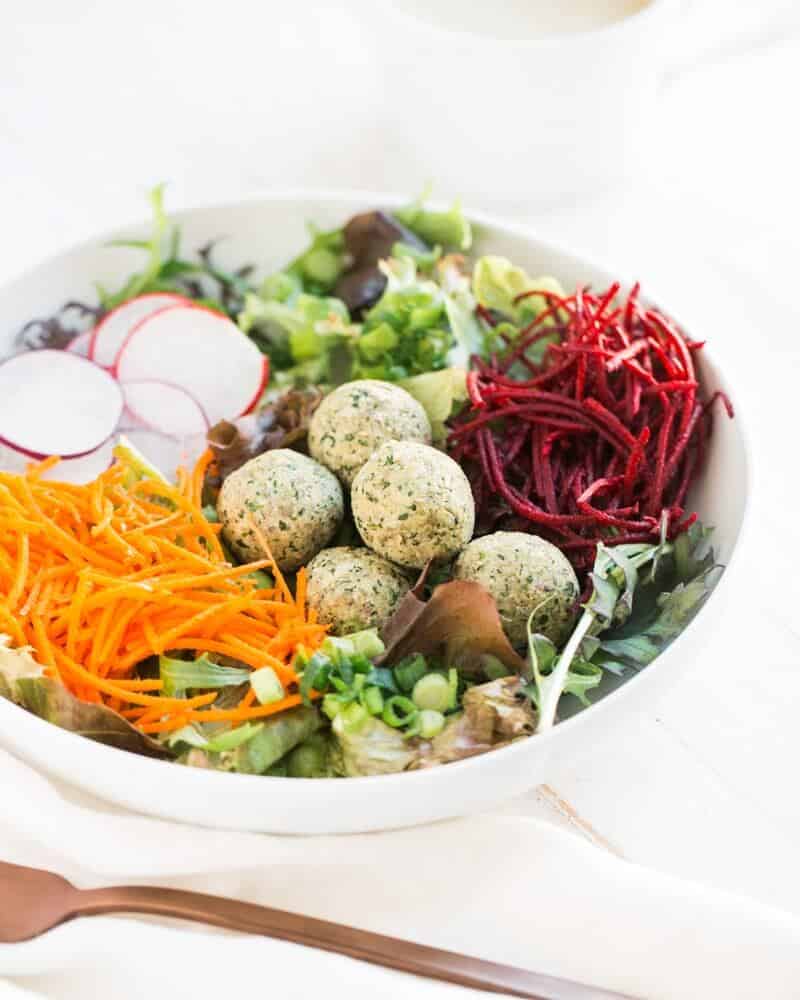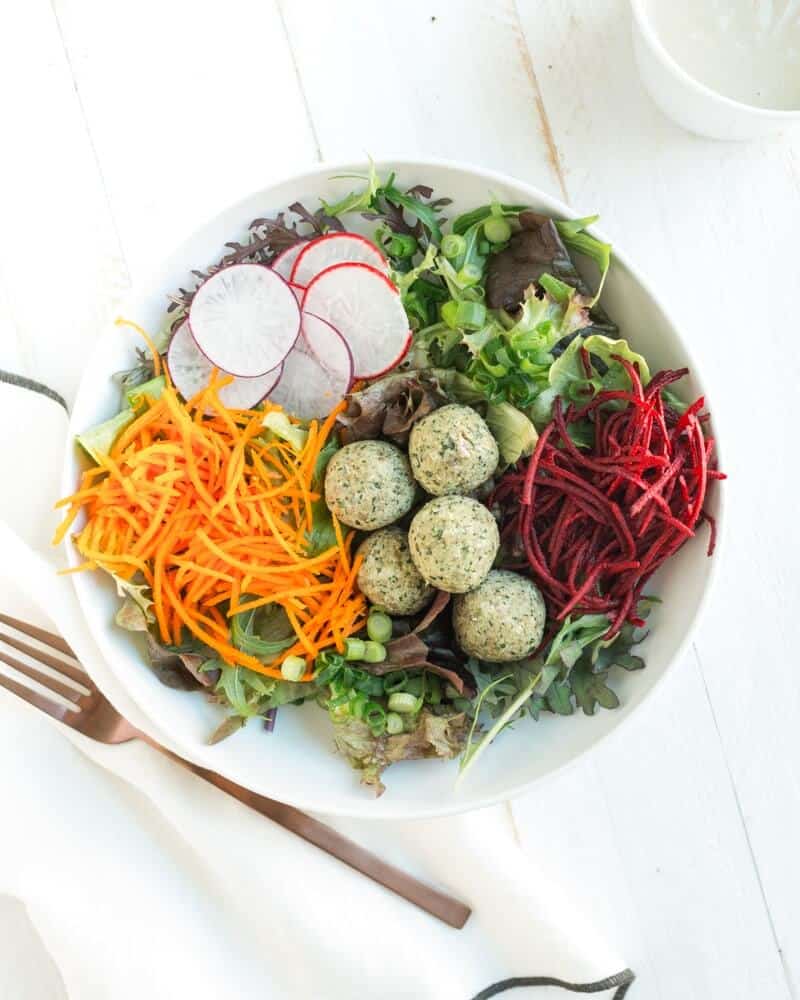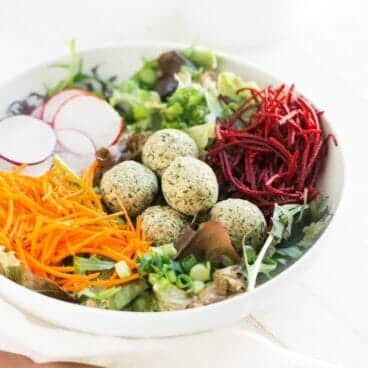Since we started cooking and eating seasonally, we’ve gotten a lot of questions: How do you find recipes to make? How do you shop affordably for fresh food at the farmer’s market? How do you select the right produce? Like our approach to food, it’s something we’ve learned by doing it. We like to call it Just Jump In. That is, simply go to the farmer’s market, find something that looks delicious, and then use the internet and cookbooks to try to find a fun way to use it. Now, that might sound a little too simple. True, we have picked up a few tips and tricks along the way. But honestly, it’s the way to go. Once you’re ready to jump in: here are a few tips for shopping the farmer’s market — and this incredible raw falafel recipe! Love falafel? Here’s how to make Classic Falafel (fried!) and an Epic Falafel Sandwich. Or try our easy Falafel Burger.
What is raw falafel?
The idea for the raw falafel bowl came from Chef Audrey at Ezra’s Enlightened Cafe in Indianapolis. My favorite item on the menu is a bowl with raw falafel and a tahini dressing. Here’s our take on recreating it! Raw falafel may sound a bit odd, but they’re incredibly good: our version is made with sunflower seeds, herbs and spices. Also of note: these raw falafel are made without a dehydrator. Many recipes online use a dehydrator, but ours simply uses a food processor. The main dish salad is super filling and covered in a creamy, lemon tahini dressing with a hint of maple. We tried this meal out on a few friends and got rave reviews!
Farmer’s market tips
Here are our top tips for shopping the farmer’s market without breaking the bank or breaking into a sweat.
1) Just do it!
Get yourself out of bed on Saturday morning and get to the market. Even if you’ve never been, the sights and smells alone will energize you! Plus, there’s usually coffee.
2) Understand seasonality.
This takes a little practice, but you’ll need to start to understand what’s seasonal and when in your area. This is crucial to finding good deals: produce will be cheapest when it is in season and just going out of season! To do so, look for seasonality charts for your region online. Or, the way we’ve learned was simply showing up at farmer’s markets and taking note of what’s available and when.
3) Check for local.
Some farmer’s markets will allow for non-local produce to be sold. We’ve seen some “too good to be true” looking produce at some markets. If you’re looking for local produce, don’t be afraid to ask for the source.
4) Think eggs.
Eggs can be some of the most economical items at the farmer’s market! We eat them for filling lunches or dinners (think frittatas, quiches, scrambled egg tacos). As a vegetarian protein, it can’t be beat.
5) Load on the greens.
Greens are a versatile way to shop the market, and typically they’re reasonably priced. Look for salad green mixes, which are tender and delicious, typically much tastier from the market than the grocery store. Also, stock up on bunches of chard, kale, and collard greens: you can use them in anything: omelettes, soups, sandwiches, and curries.
6) Price = value.
Farmer’s markets can get pricey. When we shop, we try to limit to just a few choice items outside of eggs and greens. You can get some incredible deals if you find the right products and vendors. Also, some foods are treats that are worth the extra spend, like juicy seasonal berries and peaches. Overall, we view the incremental dollars we spend as an investment in local farming — and we happen to get delicious produce at the same time. Many farmer’s markets also accept programs like SNAP to make this produce affordable for all.
7) Ask the farmer.
The great thing about a farmer’s market is that you can chat with the actual farmer (or their employees)! Ask them how to look for the freshest of their produce, and even to help you pick some out. We’ve formed lasting relationships with farmers in our area simply from meeting them at markets.
8) Consult the farmer’s market booth.
Most markets have a main information booth. This is a great place to can ask all your questions about where to find certain produce and what’s currently in season.
9) Window shop before making a purchase.
We like to do a full lap around the market before we decide what we need. This way, you can comparison shop and find the produce that best strikes your fancy.
10) Search the web.
There are many websites, like ours, devoted to creating recipes with seasonal produce. Just go to our Recipes listing and search for an ingredient!
This raw falafel recipe is…
Vegetarian, gluten-free, vegan, plant-based, and dairy-free.
Looking for more healthy bowl meals?
Outside of this grain bowl with roasted fall vegetables, here are some of our favorite healthy bowl meal recipes: 5 from 5 reviews
1 cup sunflower seeds (plus ¼ cup if needed) 2 tablespoons minced red onion or shallot 1 garlic clove 2 handfuls cilantro ½ teaspoon coriander ¾ teaspoon cumin 1 tablespoon tahini 1 tablespoon fresh lemon juice ½ teaspoon kosher salt Black pepper
For the dressing
Best Lemon Tahini Sauce
For the bowls
12 cups mixed baby salad greens 2 rainbow carrots 3 to 4 radishes (or Pickled Radishes) 1 beet
Chickpea Couscous Bowls with Tahini SauceGrain Bowls with Roasted Fall VegetablesGreek Sofrito Quinoa BowlGo Green BowlsVegetarian Quinoa Bibimbap BowlsChickpea Fattoush BowlsThai Salad with Peanut Sauce DressingBroccoli and Turmeric Yellow Rice BowlsVeggie Burrito Bowls with Cauliflower Rice


